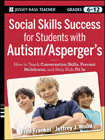
Social skills success for students with autism / Asperger's: helping adolescents on the spectrum to fit in
Frankel, Fred
Wood, Jeffrey J.
The only evidence-based program available for teaching social skills to adolescents with autism spectrum disorders Two nationally known experts in friendship formation and anxiety management address the social challenges faced by adolescents with autism spectrum disorders (ASD). The book helps educators instruct youth on conversing with others, displaying appropriate body language, managing anxiety, initiating and participating in get-togethers, and more. The book is filled with helpful information on ASD to aid teachers who have received little training on the topic. Extremely practical, the book includes lesson plans, checklists, and sidebars with helpful advice. Based on UCLA's acclaimed PEERS program, the only evidence-based approach to teaching social skills to adolescents with ASD Contains best practices for working with parents, which is the key to helping kids learn social skills The authors discuss the pros and cons of teaching students with ASD in educational settings like full inclusion (good for academics but bad for social skills) and pull-out special day classes (where the reverse is true) Provides a much-needed book for teachers at all levels for helping students develop the skills they need to be successful. ÍNDICE: Acknowledgments Introduction Our Approach to Social Skills Training The Knowledge Base Behind This Book Children's Friendship Training/PEERS Cognitive-Behavioral Strategies for Emotional Self-Regulation The Purpose of ThisBook How to Use This Book Part One: Basic Information About Teens with AutismSpectrum Disorder Chapter 1: What Is Autism Spectrum Disorder? Challenges Facing Neurotypical Teens Becoming Independent from Parents Preparing for a Vocation or Career Adjusting to the Physical and Psychosexual Changes of Puberty Developing Values and Identity Establishing Effective Relationships with Peers Symptoms of Autism Spectrum Disorders Misleading Aspects of Communication Deficits in Expression and Communication Easily Corrected Deficits in UnderstandingOthers Coping with Anxiety-Producing Situations Chapter 2: Making Inclusion More Successful for Students with Autism History of the Inclusion Movement Parent Views About Inclusion Types of Educational Placement Traditional Teacher Roles in Partially and Fully Included Classrooms Research Findings on Inclusion Social Integration into School Life Mainstream Success of Students on the Autism Spectrum Approaches for Social Inclusion with Neurotypical Teens Teen Altruism Chapter 3: Classroom Management and Social Skills Groups Classroom Management for Teens with Autism Spectrum Disorders Segregated Students Partially Included Students Fully Included Students Consequences for Misbehavior OrganizingSocial Skills Groups for Teens How to Organize Groups at School How to Have Teens Take the Class How to Engage Teens in Class Discussions Have Some Fun Activities Have Real-Life Homework Involving Parents in Social Skills Training Part Two: Interventions for Basic Social Skills Chapter 4: Helping Students Expand Their Interests Problems in Conversation Versus Problems in Interests Socially Functional Interests Interference Due to Anxiety Building on Current Interests Assessing Teen Interests Lessons to Expand Interests Chapter 5: ImprovingComprehension of Figurative Language Idioms Irony and Sarcasm Types of Sarcasm Recognizing Sarcasm Teaching Sarcasm and Irony Chapter 6: Improving Conversational Comprehension Goals of Conversations Ensuring Mutual Understanding Conversational Repair Strategies Teaching Better Task-Oriented Conversations, Accuracy Checks, and Repair Statements Chapter 7: Improving Social Conversations Potential Understanding of Conversational Goals Small Talk Parts of Conversations Chapter 8: Helping Students Choose Friends Neurotypical Teen Relationships Friends of Teens with Autism Spectrum Disorders The Internet and Friendships Appropriate Friends for Teens on the Spectrum Common Errors Adults Make in Offering Friendship Help Requiring Inclusion Attempting to Pair Students AssigningPeer Buddies How Educators Can Help Foster Friendships of Teens on the Spectrum Part Three: More Intensive Interventions to Help Kids Fit In Chapter 9: Understanding and Assessing Anxiety How Anxiety
- ISBN: 978-0-470-95238-2
- Editorial: John Wiley & Sons
- Encuadernacion: Rústica
- Fecha Publicación: 28/10/2011
- Nº Volúmenes: 1
- Idioma: Inglés
